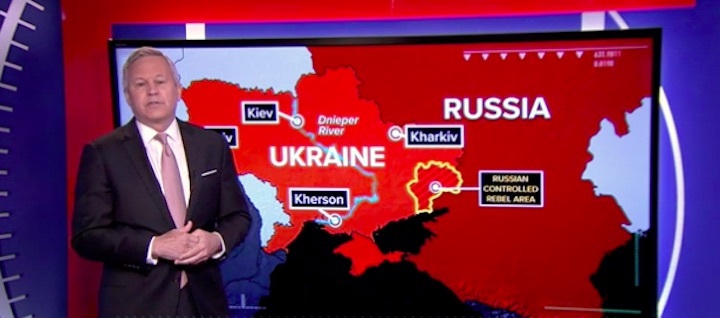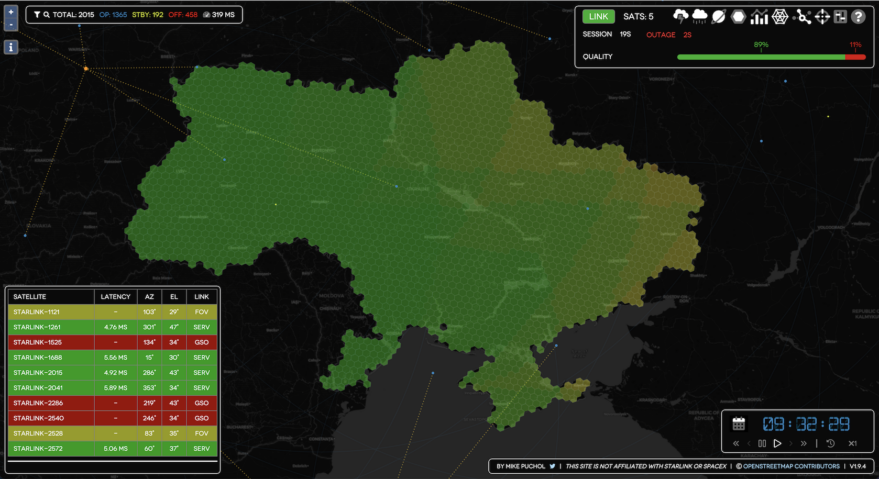1.03.2022


This story was updated March 1 at 1:55 p.m. EST
WASHINGTON — SpaceX CEO Elon Musk said Saturday that he’s sending Starlink terminals to Ukraine to help keep the embattled country connected to the outside world as Russia steps up its invasion.
Details of SpaceX’s Starlink assistance remain under wraps. And while it’s not clear how quickly the promised Starlink broadband terminals will be up and running inside Ukraine, SpaceX’s response was another remarkable example of private companies and connected citizens pushing back on Russia’s effort to subjugate its neighbor.
“I wish I could say more,” Musk told SpaceNews. “But, yeah, I was thinking the same thing. Strange that SpaceX can do this.”
As Russian forces were closing in on Kyiv on Saturday afternoon local time, Ukraine’s minister for digital transformation called on Musk via Twitter to send Starlink terminals.
“@elonmusk, while you try to colonize Mars — Russia try to occupy Ukraine! While your rockets successfully land from space — Russian rockets attack Ukrainian civil people! We ask you to provide Ukraine with Starlink stations and to address sane Russians to stand [down],” tweeted Ukrainian Vice Priminister Mykhailo Fedorov.
While Musk declined to talk about what transpired behind the scenes, just over 10 hours later — half past midnight in Kyiv — Musk publicly responded that help was on the way.
“Starlink service is now active in Ukraine. More terminals en route,” Musk tweeted in reply to Fedorov.
Late Sunday, a senior Ukrainian space official told SpaceNews that Starlink terminals had not arrived but were on the way.
“I’ve heard from the minister himself that the first batch of terminals is coming. Not here yet. But this is not critical at all. No problems with connection for now in all regions of Ukraine,” Volodymyr Usov, former chairman of the Ukrainian State Space Agency and co-founder of Kyiv-based Kurs Orbital, told SpaceNews via a messaging app.
Early Monday, Kyiv time, Usov said that telecommunications were still up and running inside Ukraine, easing the urgency for Starlink terminals. “We anticipated the disruption of our comms, but didn’t happen,” he said.
Nevertheless, he expressed gratitude for SpaceX’s quick response. “Thanks to Elon for his support and good outreach,” Usov said. “Starlink can prove to be useful, especially outside big cities.”
Shortly after 10 p.m. Monday, Kyiv, Fedorov tweeted that a truckload of Starlink terminals had arrived.
Uplink’s downside?
Analyst John Scott-Railton, a senior researcher at the University of Toronto’s Citizen Lab who studies connectivity in conflict regions, warned over the weekend that Starlink uplinks could make Ukrainian combatants and noncombatants alike a target for Russian airstrikes.
“Good to see,” Scott-Railton tweeted Feb. 26. “But remember: if #Putin controls the air above #Ukraine, users’ uplink transmissions become beacons…for airstrikes.”
“[E]arly in a conflict w/disrupted internet, satellite internet feels like a savior. But it quickly introduces very real, deadly new vulnerabilities. If you don’t understand them, people die needlessly until they learn & adapt,” Scott-Railton wrote.
“#Russiahas decades of experience hitting people by targeting their satellite communications. In 1996, Chechen president Dzhokhar Dudayev was careful, but Russian aircraft reportedly found his satphone call & killed him with a missile strike.”
“Satellite phones tend to send signals out in all directions. Making them easy targets. The technology for locating & intercepting them is well-honed. This is different from [S]tarlink…In more recent years, other [kinds] of tech has entered the conflict-zone game. Like VSATs. In Syria, Libya, etc etc. VSATs have played a pivotal role in communications. Everyone uses them. They have a more *directional* signal & typically provide broadband data.”
“In Syria, ISIS reportedly came up w/ various tactics to avoid being killed by strikes against their satellite internet terminals,” Scott-Railton wrote. “These [include] distancing dishes away from their installations and covertly taking a connection from civilian internet café VSATs”
For a Russian invasion force that appears to be having trouble with core logistics, like keeping its armored vehicles fueled, the sort of sophisticated signals-intelligence operation that would be necessary to distinguish friend from foe and combatants from noncombatants is largely theoretical at this point, at least for Ustov and his fellow Ukrainians.
“No concerns at all regarding location security,” Ustov said.
Making the connection

Brian Weeden, a former U.S. Air Force officer and military space specialist at the Secure World Foundation think tank in Washington, said that Scott-Railton is correct that Starlink terminals are potentially targetable, he doesn’t think they would rank as high-value targets.
“It is true that the Starlink ground terminals will be broadcasting, and thus potentially targetable using RF signal detection equipment. But I doubt they’d be that high of a priority for Russian targeting, so I think the odds of them being targeted is probably low,” Weeden said Monday by email. “A much bigger challenge would be Russian ground-based mobile jamming, which is sophisticated and can already deal with existing satellite signals such as GPS and satellite communications.”
Weeden said the near-term utility of sending Starlink terminal to Ukraine could be limited by a lack of teleports covering Europe’s largest country by area (after Russia).
“The other big challenge is the lack of operational teleports covering Ukraine, which are necessary to link end user requests to the Internet,” Weeden said. “As far as I know, the only operational teleports covering Ukraine are in Poland, so I don’t think the eastern part of Ukraine can actually use Starlink service.”
Mike Puchol, the chief technologist of a Kenya-based wireless internet service provider who built and maintains a popular Starlink coverage tracker in his spare time, told SpaceNews that Ukraine appears to be fully covered, perhaps with less total Starlink capacity over Eastern Ukraine.
Puchol’s tracker simulates the links between gateways, satellites, and user terminals based on SpaceX filings and other public sources of information.
“We know of three teleports, or gateways…one from regulatory filings in Poland, the second from photos in Turkey at a specific location, and the third from a construction company posting a photo in Latvia,” Puchol told SpaceNews. “The location of the latter is not accurately known, but has been placed on my tracker at the most probable location you would build one.”
Puchol said the gateways in Poland, Turkey and Latvia “can provide full service over all of Ukraine, with less simultaneous satellites covering the Eastern part of the country.”
“[T]here could be additional gateways that we don’t know of, as SpaceX doesn’t make their locations public,” Puchol said.
A Starlink user in Kyiv, he said, can expect their terminal to be serviced by one of five to eight Starlink satellites at any given time.”
Early adopter
One of the first Starlink users in Ukraine, if not the first, is Oleg Kutkov, a Kyiv-based engineer with a master’s degree in computer science from Kharkiv National Aerospace University.
Kutkov, a self-described hardware hacker, bought a Starlink terminal off eBay in December to tinker with in his home workshop. On Monday evening, Kyiv time, Kutkov got his Starlink connection up and running with a little tech support help via chat. “The initial registration address was in the U.S., and I couldn’t change it to my Ukraine location,” Kutkov said. “The SpaceX team helped me to solve this issue.” Leaning the dish out his apartment window, Kutkov was able to get download speeds well over 100 Mbps, he said.
SpaceNews spoke with Kutkov on Tuesday via video teleconference. Since his apartment’s fiber-optic internet connection is still working, he’s taken his Starlink dish down for now.
Kutkov, who knows Puchol through their shared Starlink interests, told SpaceNews that Starlink satellite and teleport coverage appears to be adequate. “I believe that all of Ukraine territory should be covered. I also check satellite coverage,” he said. “Ukraine should be fine, at least northern Ukraine where there’s Kyiv and our major cities.”
Kutkov said he had not heard anything official about Ukraine’s plans for distributing the Starlink dishes or how many the country can expect to receive. “But I think they should distribute the terminals between military and government facilities. That would be most logical.”

Kutkov understands that any device that emits a strong enough radio-frequency or infrared signature can theoretically be used for military target identification. “I think it’s possible… I found transmission from the Dishy, its RF signal and the strength of the signals. Maybe it just transmits locally, but if [Russian military] used some sensitive receiver, maybe they could track the signal. Plus Dishy is hot, very hot, so there’s a lot of infrared radiation.”
For now, Kutkov said he is more concerned about the possibility of Kyiv’s power stations being taken out by airstrikes or artillery than Russia targeting anything with an RF or infrared signature.
Targeting combatants via Starlink uplink signals might be way down the list of near-term risks, However, Scott-Railton said Ukrainians should heed lessons from past conflicts.
“A well-resourced military tracks a massive variety of radio emissions during a war. Even if capabilities are not initially specced out for a novel new communications protocol, if the transmission is interesting enough / the users worth killing, it will be worked on…”
To that end, he shared a link to a 2013 case study he wrote for the U.S. Naval War College.
Quelle: SN
